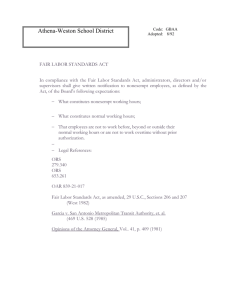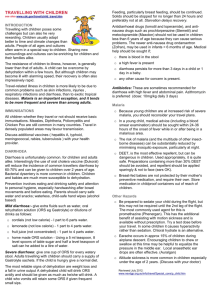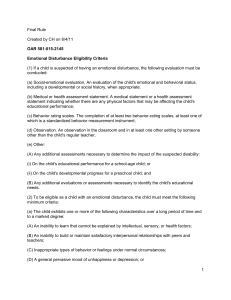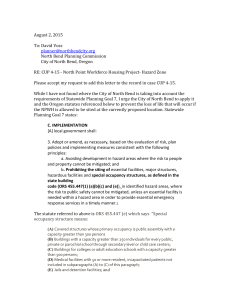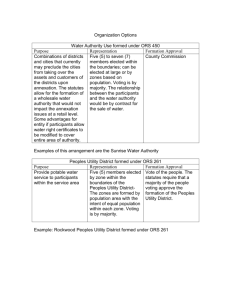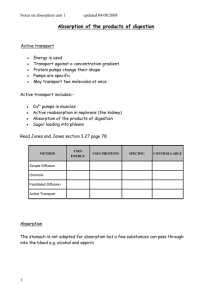3.Acute Diarrhoea Management in Children
advertisement
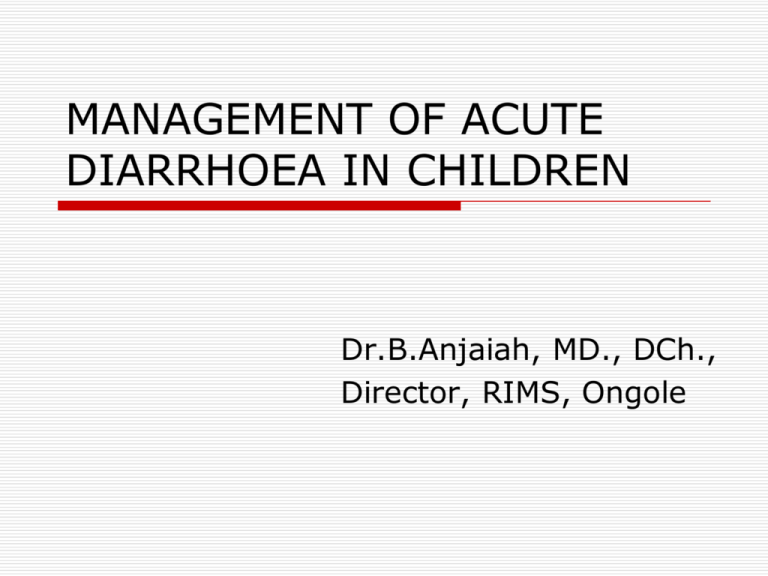
MANAGEMENT OF ACUTE DIARRHOEA IN CHILDREN Dr.B.Anjaiah, MD., DCh., Director, RIMS, Ongole INVESTIGATIONS STOOLMacroscopy Microscopy- WBC>10/hpf Ova,cysts,throphozoites Hanging drop C/S for shigella & salmonella BLOODCBC Electrolytes, creatinine,BUN C/S MANAGEMENT PREVENTION TREATMENT SUPPORTIVE TREATMENT PREVENTION HAF Good liquids without salt -clean water -unsalted rice water -unsalted yoghurt drinks -coconut water -weak tea -unsweatened fresh fruit juice Good liquids with salt -ORS -Salted soup -salted yoghurt drinks -salted rice water DO NOT GIVE Soft drinks Sweetened tea Sweet fruit juices coffee TREATMENT CORNERSTONE of Rx ORT ORT ORS Solution made from sugar &salt Food based solutions Continued feeding PLAN A (NO DEHYDRATION) Rule 1 --- Fluids - HAF,SSS Rule 2 --- Zn supplementation Rule 3 --- continued feeding Rule 4 --- return to clinic Rule 1 --- Fluids WHO Guidelines AGE <6 mon QUANTITY WITH EACH STOOL 50 ml(1 cup) 7 mon – 2 yrs 50-100 ml 2 yrs- 5 yrs 100-200ml Older child As much as they take ORS is optional in PLAN A Rule 2 --- Zn supplementation Improves immune function Improves intestinal permeability Regulation of intestinal water & electrolyte transport & brush border enzymatic function Intestinal tissue repair Rule 2 --- Zn supplementation <6 mon ---- 1/2 tab / day >6 mon ---- 1 tab / day for 10 – 14 days Rule 3 --- continued feeding < 6 mon - breast / top fed Older children – cereals & beans, meat & fish , oil, dairy products & eggs, fruit juices & bananas What is the use of continued feeding? Rule 4 --- return to clinic When the child -passes many stools -very thirsty -sunken eyes -fever -does not eat/drink normally PLAN B (Some dehydration) AGE Weight ORS Glass < 4 mon <5 kgs 200-400 ml 1-2 4-11mon 5-8 kgs 400-600 ml 2-3 12-23 mon 8-11 kgs 600-800 ml 3-4 2-4 yrs 11-16 kgs 800-1200 ml 4-6 5-14 yrs 16-30 kgs 1200-2200ml 6-11 >15 yrs >30 kgs >2200 ml 12-20 ORS given at 75 ml / kg over 4 hrs Continue breast feeding 100-200 ml of water + ORS (in those who are not breastfed) REASSESS after 4 hrs Signs of dehydration NIL PERSISTS SEVERE --- follow - PLAN A - PLAN B - PLAN C PLAN C (Severe dehydration) AGE First give 30 ml / kg in < 1 year 1 hour > 1 year 30 min Then give 70 ml / kg in 5 hrs 2 ½ hrs TYPE OF FLUID BEST ----- RL IDEAL ----- RL + 5% D IF RL not available ---- NS INDICATIONS FOR IV FLUIDS Severe dehydration with/with out shock Persistent vomiting(>3/hr) Failure to correct / worsening of dehydration on ORT High purge rate Failure of acceptance of ORS in dehydrated child Abdominal distension Deranged sensorium GUIDELINES for the total amount of fluids to be replaced in some & severe dehydration Usual fluid Deficit (ml/kg) Deficit fluid replaced (ml/kg) Maintainence fluid required in 8 hrs (ml/kg) Total amount of IV fluids for correction of dehydration to be given in 8 hrs (ml/kg) Some 70-100 50 50 100 Severe 120-180ml 100 50 150 CONTINUATION OF IVF AFTER CORRECTION OF DEHYDRATION Children - >3 mon N/4 NS -<3 mon N/6 NS Maintenance fluids must contain K+ in the con of 20 meq/l TYPE OF FLUID GIVEN AS REHYDRATION THERAPY Initial fluid of choice-N/2 NS(1 PART OF ISOTONIC SALINE+1 PART 5% DEXTROSE) Isotonic saline & RL - severe dehydration ->6y high purge rate Start ORS -5ml/kg/hr when child able to drink what to do if IV LINE not accessible? Reasses after 1-2 hrs COMPLICATIONS Dehydration Dyselectrolytaemia Precipitation of malnutrition Secondary lactose intolerence Persistent diarrhoea HUS DIC Cortical vein thrombosis HYPONATRAEMIA Severe-<125meq/l Clinical features Deranged sensorium&convulsions Diminished urine output Correction-N/2 NS (or) RL [Na-125-135] -3N NS [Na-<125] Amount of Na required=Na deficit x 0.6 x wt Half of it corrected as 3N over ½-1hr Remaining corrected as RL (or) N/2 NS slowly HYPERNATRAEMIA Etiology Clinical features Usual signs of dehydration are absent Management If in shock-20-30ml/kg RL Confirm hypernatraemia Give N/3 NS in maintenance amounts METABOLIC ACIDOSIS Etiology Clinical features-deep fast breathing with plasma HCO3 <15 meq/lit Management Amount of NaHCO3= HCO3 deficit x 0.6 x wt (OR) 3ml/kg of 7.5% NaHCO3 diluted 6 times 5% Dextrose [total of 20ml/kg] over 30-60 min HYPOKALEMIA Serum K- <3 Meq/l Clinical features Management- ORS -K rich food Oral potassium supplementation -2meq/kg/d in PEM WHO Formula gm/ lit component Mmol/lit NaCl 3.5 Na 90 KCl 1.5 K 20 Tri sodium 2.9 citrate Glucose 20 Cl 80 Citrate 10 water Glucose 111 1Lit Various measures to reduce Na Lower Na content in ORS Alternating breast milk and ORS(2:1) Diluting ORS in 1.5 lit of water Limitations of ORS Does not decrease the volume frequency severity of diarrhoea Does not stop diarrhoea IMPROVED ORS Should reduce amount & rate of purging Should stop diarrhoea Should provide nutritional support (SUPER ORS) FORMULATIONS Amino acid Glycine / L-alanine / Lglutamine added to glucose ORS Decreasing conc. Of glucose & sodium Cooked cereal powder esp. rice to replace glucose Combining glucose polymers & AA’s to replace glucose Polymers like maltodextrine to replace glucose CEREAL baesed ORS 50 gm/lit of cooked rice added to salt ADVANTAGES? REDUCED OSMOLARITY ORS Principle? Gms/lit Mmol/lit NaCl 2.6 Na 75 Glucose 13.5 Cl 65 KCl 1.5 Glucose 75 Tri Na cit 2.9 K 20 Citrate 10 Osm 245 Amylase resistant starch in ORS Add 50 gm/lit of starch to standard glucose ORS Increases absorption efficiency ReSoMal Component Glucose Na K Cl Citrate Mg Zn Cu Osmolarity Standard ORS 111 mmol/lit 90 20 80 10 311 ReSoMal 125mmol/lit 45 40 70 7 3 0.3 0.045 300 DRUG THERAPY SHIGELLA Cotrimoxazole(5d) CHOLERA Tetracycline/ Doxy (3-5d) (1dose) AEROMONAS cotrimoxazole ETEC & EPEC -do- Campylobacter Erythromycin(5-7d) Clostridium difficile Giardiasis Vancomycin/ metronidazole Ampicillin/ Cefotaxime(5-7d) Metronidazole(5d) Amoebiasis Metronidazole(7-10d) Salmonella RACECADORTIL Mode of action Comparing with Loperamide MULTIVITAMINS Vit A- on day 1,2 and 14 Folic acid- 5 mg on day 1 then 1mg/d for 2 wks Other vitamins and trace elements double the maintanance dose MICRONUTRIENTS Potassium-5-6 meq/kg/d for few days 2-3 meq/kg/d orally for 2wks MgSO4-0.2ml/kg Zinc-10 mg for 2wks Copper-0.3 mg/kg/d Iron PROBIOTICS IN DIARRHOEA Viable microbial supplements / live microorganisms given to confer beneficial health effects on the growth of the host Lactobacillus acidophilus/ L.casei Bifidobacterium Streptococcus thermophilius Saccharomyces PREBIOTICS IN DIARRHOEA Food ingredients or part of bacteria largely undergraded in small bowel and can beneficially affect the host by stimulating colonic bacteria Lactulose alfa disaccharide Fructo-oligosaccharide In some vegetables and fruits USES OF PRE/PROBIOTICS Establishes normal microbial flora Enhancement of immunity Nutritioal benefits-vit B Production -improved digestibility -body growth MECHANISMS OF ACTION Competing for receptor sites Growth inhibition Immune modulation Production of short chain fatty acids Modification of toxin receptors Disaccharidases Decreases permeability DIARROEA IN PEM Clinical features MANAGEMENT Mild to moderate-ORS 70-100 ml/kg over 6-12 hrs Severe – N/2 NS+5%D 30ml/kg – 2hr -N/6 NS+5%D 10ml/kg- 10hr -N/6 NS+5%D 5ml/kg/hr –12hr MAINTENANCE FLUIDS-N/6 NS in 5% D -75-100 ml/kg/d NUTRITION IN PEM The goal – 150-200 kcal -3-4g protein -6-8 feeds Micronutrients & multi vitamins Trace elements
